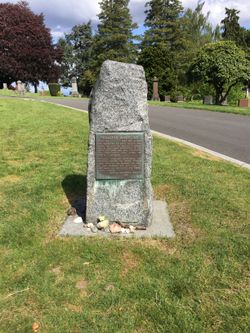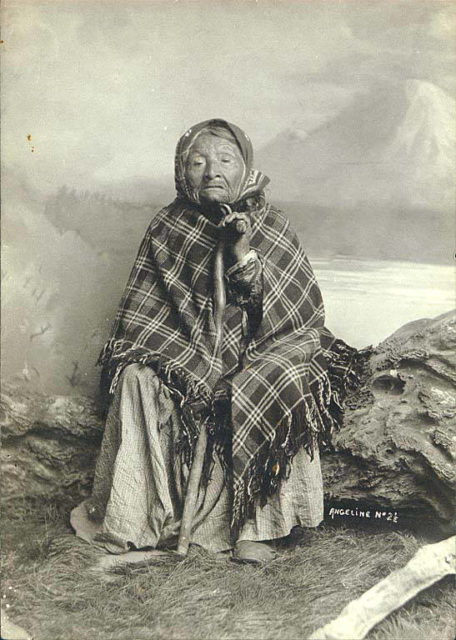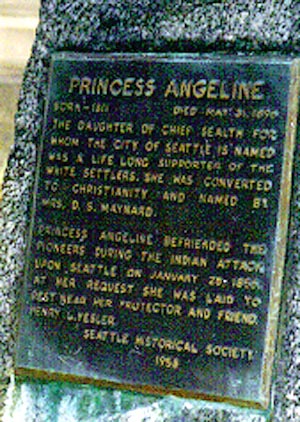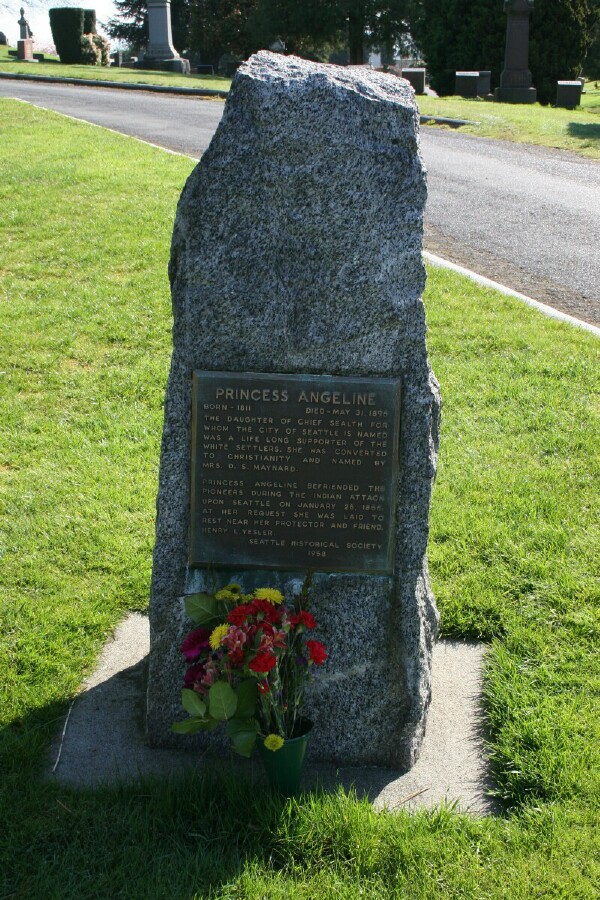https://en.wikipedia.org/wiki/Princess_Angeline∼Born in 1820 in Lushootseed, near modern day Seattle, Kikisoblu (Kick-is-om-lo) was the first daughter of Chief Seattle, the leader of a Suquamish Tribe (Suquamish) and Dkhw’Duw’Absh (Duwamish). When American settlers arrived in Seattle, Chief Seattle befriended one of them, David Swinson “Doc” Maynard.
When the second wife of “Doc” Maynard, Catherine Maynard, saw the beautiful Kiksoblu, she said, “You are too good looking for a woman to carry around such a name as that, and I now christen you Angeline.”
n 1855, when Angeline was in her mid-30s, the U.S government, with the Treaty of Point Elliott, forced all the Suquamish Indians away from their land and onto a reservation. Rather than joining this exodus, Angeline refused to leave her home in Seattle and stayed in her waterfront cabin on Western Avenue, between Pike and Pine Streets, near what is now Pike Place Market. She gained the title “princess” because of her father, but also for her bold and dignified manner despite her situation.
Princess Angeline stayed true to her roots, but had to make a living, so she did laundry for the settlers and sold native handicrafts such as handwoven baskets that she made in the evening. Princess Angeline was living in two worlds; one that was slowly fading away, of which she was the ghost, and the other where she was alone and poor.
As Princess Angeline grew older she developed arthritis, but that didn’t stop her from her daily routines. She became a recognizable figure on the streets of Seattle, with a shawl and a red handkerchief over her head, and the locals became attached to her.
Following the steps of her father, Princes Angeline became a Christian and remained in the Roman Catholic Church until her death on May 31st, 1896. Princess Angeline, upon her death, was given a decent funeral in Seattle’s Church of Our Lady of Good Help. Her coffin was in the shape of a canoe.
May 29, 1896. With the death of Angeline Seattle died the last of the direct descendants of the great Chief Seattle for whom this city was named. Angeline—Princess Angeline—as she was generally called, was famous all over the world… Angeline was a familiar figure of the streets, bent and wrinkled, a red handkerchief over her head, a shawl about her, walking slowly and painfully with the aid of a cane; it was no infrequent sight to see this poor old Indian woman seated on the sidewalk devoutly reciting her beads. The kindness and generosity of Seattle’s people toward the daughter of the chief… was shown in her funeral obsequies which took place from the Church of Our Lady of Good Help. The church was magnificently decorated; on the somber draped catafalque in a casket in the form of a canoe rested all that was mortal of Princess Angeline.
-photograph-by-darius-kinsey-of-princess-angeline-1820-1896-daughter-of-chief-seattle
Photograph by Darius Kinsey of Princess Angeline
Years after Princess Angeline died, her cabin was torn down, and the area became a part of the waterfront until Pike Place Market was formed.
https://en.wikipedia.org/wiki/Princess_Angeline∼Born in 1820 in Lushootseed, near modern day Seattle, Kikisoblu (Kick-is-om-lo) was the first daughter of Chief Seattle, the leader of a Suquamish Tribe (Suquamish) and Dkhw’Duw’Absh (Duwamish). When American settlers arrived in Seattle, Chief Seattle befriended one of them, David Swinson “Doc” Maynard.
When the second wife of “Doc” Maynard, Catherine Maynard, saw the beautiful Kiksoblu, she said, “You are too good looking for a woman to carry around such a name as that, and I now christen you Angeline.”
n 1855, when Angeline was in her mid-30s, the U.S government, with the Treaty of Point Elliott, forced all the Suquamish Indians away from their land and onto a reservation. Rather than joining this exodus, Angeline refused to leave her home in Seattle and stayed in her waterfront cabin on Western Avenue, between Pike and Pine Streets, near what is now Pike Place Market. She gained the title “princess” because of her father, but also for her bold and dignified manner despite her situation.
Princess Angeline stayed true to her roots, but had to make a living, so she did laundry for the settlers and sold native handicrafts such as handwoven baskets that she made in the evening. Princess Angeline was living in two worlds; one that was slowly fading away, of which she was the ghost, and the other where she was alone and poor.
As Princess Angeline grew older she developed arthritis, but that didn’t stop her from her daily routines. She became a recognizable figure on the streets of Seattle, with a shawl and a red handkerchief over her head, and the locals became attached to her.
Following the steps of her father, Princes Angeline became a Christian and remained in the Roman Catholic Church until her death on May 31st, 1896. Princess Angeline, upon her death, was given a decent funeral in Seattle’s Church of Our Lady of Good Help. Her coffin was in the shape of a canoe.
May 29, 1896. With the death of Angeline Seattle died the last of the direct descendants of the great Chief Seattle for whom this city was named. Angeline—Princess Angeline—as she was generally called, was famous all over the world… Angeline was a familiar figure of the streets, bent and wrinkled, a red handkerchief over her head, a shawl about her, walking slowly and painfully with the aid of a cane; it was no infrequent sight to see this poor old Indian woman seated on the sidewalk devoutly reciting her beads. The kindness and generosity of Seattle’s people toward the daughter of the chief… was shown in her funeral obsequies which took place from the Church of Our Lady of Good Help. The church was magnificently decorated; on the somber draped catafalque in a casket in the form of a canoe rested all that was mortal of Princess Angeline.
-photograph-by-darius-kinsey-of-princess-angeline-1820-1896-daughter-of-chief-seattle
Photograph by Darius Kinsey of Princess Angeline
Years after Princess Angeline died, her cabin was torn down, and the area became a part of the waterfront until Pike Place Market was formed.
Inscription
The daughter of Chief Sealth for
whom the city of Seattle is named
was a life long supporter of the
white settlers. She was converted
to Christianity and named by
Mrs D. S. Maynard.- 1811
Princess Angeline befriended the
pioneers during the Indian attack
upon Seattle on January 26, 1856.
At her request she was laid to
rest near her protector and friend,
Henry L. Yesler.
Seattle Historical Society
Gravesite Details
Eldest daughter of Chief Seattle





















